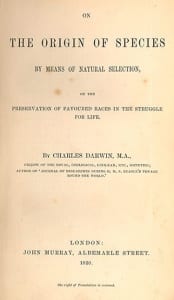
Biology has changed a lot over the past 150 years. Scientists have discovered entirely new forms of life, deciphered the molecular code of heredity and observed the machinery of life on the smallest dimensions. And through it all, one scientific theory has stood the test of time.
The Origin of Species
New discoveries in genomics, medicine, developmental biology, and countless other fields could have derailed the the theory of evolution. But the core principles of evolutionary theory, proposed by Charles Darwin 150 years ago, have remained among the strongest explanations of the natural world ever published.
In honor of Darwin Day 2009, which celebrates the 200th anniversary of Charles Darwin’s birth and the 150th anniversary of the publication of his seminal work, On the Origin of Species, we’d like to take a look at how evolution has itself ‘evolved’ over the decades – how new advances in science and technology have both reinforced Darwin’s original idea and given us insight into the inner workings of the theory that explains so much about the world in which we live.
In 1859, the phrase ‘evolution by natural selection’ was already beginning to make the rounds among the scientific elite in Europe and in America. This was the year Darwin published On the Origin of Species, and his ideas about how species change over time were causing heated debate among the experts.
Theory of Evolution
But Darwin didn’t invent the idea of ‘evolution’ (that is, the idea that species change over time). What he brought to the table was an explanation of how species change, a process Darwin called ‘natural selection.’ On his famous journey to the Galapagos Islands 25 years earlier, Darwin had witnessed unique variation in hundreds of species.
As he pored over his notes for the next two decades, Darwin pieced together the notion that species must adapt to environmental pressures (like changes in climate or a volcanic eruption), in order to survive. If they did not adapt to these pressures, then they may not survive. It was natural selection, Darwin argued, that was the basis for the vast differences we see in plant and animal species across the globe.
But there was a lot that Darwin did not know when he published his ideas of evolution.
Natural Selection
He did not know, for instance, how changes in a species’ appearance (a longer beak, a bigger shell, or a thicker coat of fur) are passed down from generation to generation.
The idea of discrete units – ‘genes’ that are passed down from parents to children – had not even occurred to Darwin, nor to most of the other scientists of the time. Even when, in 1866, an Austrian monk named Gregor Mendel reported his ideas on patterns of inheritance in pea plants in the obscure Proceedings of the Natural History Society of Brünn, few took notice.
Genetics
In fact, the word ‘genetics’ wasn’t coined until 1905, by biologist William Bateson. Bateson, who is sometimes credited with ‘rediscovering’ the lost works of Mendel, helped to usher in a new wave of research and discovery – this time looking at how species differ from each other at the molecular, or genetic, level. Bateson’s push for the use of genetics in evolutionary research reached fruition in 1952, when Cambridge scientists James Watson and Francis Crick decoded the structure of DNA.
Soon others discovered how specific genes are passed down from generation to generation, and how changes in our genetic code are connected to changes in species. As each new genetic discovery allowed us to better understand the natural world at a microsopic level, Darwin’s theory of evolution by natural selection was continually reinforced.
The evolution of our species, Homo sapiens, forms the basis for virtually everything we can learn from 23andMe’s Personal Genome ServiceTM. The signature of millions of years of evolution is present in every person’s genome, and often in our physiology, rendering some of us resistant to malaria, others unable to digest milk, and even causing some to have lower risks of cancer or other diseases. As advances in science and technology continue to bring us more information hidden within our genes, we can be thankful that 150 years ago, an amateur naturalist from Shrewsbury, England, boarded a ship bound for South America and began piecing together the evolutionary story of not just our species but of all life on earth.

